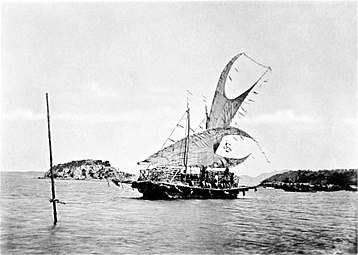
Lakatoi (also Lagatoi) are multiple-hulled[1] sailing watercraft of Papua New Guinea.[2] They are named in the Motu language and traditionally used in the Hiri trade cycle.[3]
Lakatoi (whose literal meaning is three dugouts) are fashioned from two or more dugout logs fastened together to give stability and cargo-carrying capacity.[1] The two or more dugouts are joined by booms, with a platform built on top.[4] The sail is a crab-claw sail.[5] Horridge (2008)[6] discusses the rig and how the craft is manouvred.
Gallery
[edit]-
Loading a lakatoi at Port Moresby, prior to 1885.
-
Lakatoi near Elevala Island, prior to 1885.
-
Papuan lake dwellings with a lakatoi under sail, 1898 or before.
-
1901 stamp by the British Government depicting a lakatoi.
See also
[edit]References
[edit]- ^ a b Mahdi, W. (1999). "The dispersal of Austronesian boat forms in the Indian Ocean" (PDF). Archaeology & language III, Artefacts, languages and texts: 144–208.
- ^ "Journal of the Polynesian Society: Front Matter P 1-6". Jps.auckland.ac.nz. Retrieved 2016-01-19.
- ^ "Motuan traders go west in their Lakatoi". II(8) Pacific Islands Monthly. 11 March 1932. Retrieved 26 September 2021.
- ^ Pawley, A., & Pawley, M. (1998). "Canoes and seafaring" (PDF). The Lexicon of Proto Oceanic: The Culture and environment of ancestral Oceanic society 1: Material Culture. Pacific Linguistics.
{{cite journal}}: CS1 maint: multiple names: authors list (link) - ^ "Motuan Traders Abandon Ancient Lakatoi Custom". Pacific Islands Monthly. 1935-02-21. Retrieved 2024-03-18.
- ^ Horridge, A (2008). "Origins and Relationships of Pacific Canoes and Rigs" (PDF). Canoes of Oceania. V: 85–105.









Well, that’s interesting to know that Psilotum nudum are known as whisk ferns. Psilotum nudum is the commoner species of the two. While the P. flaccidum is a rare species and is found in the tropical islands. Both the species are usually epiphytic in habit and grow upon tree ferns. These species may also be terrestrial and grow in humus or in the crevices of the rocks.
View the detailed Guide of Psilotum nudum: Detailed Study Of Psilotum Nudum (Whisk Fern), Classification, Anatomy, Reproduction